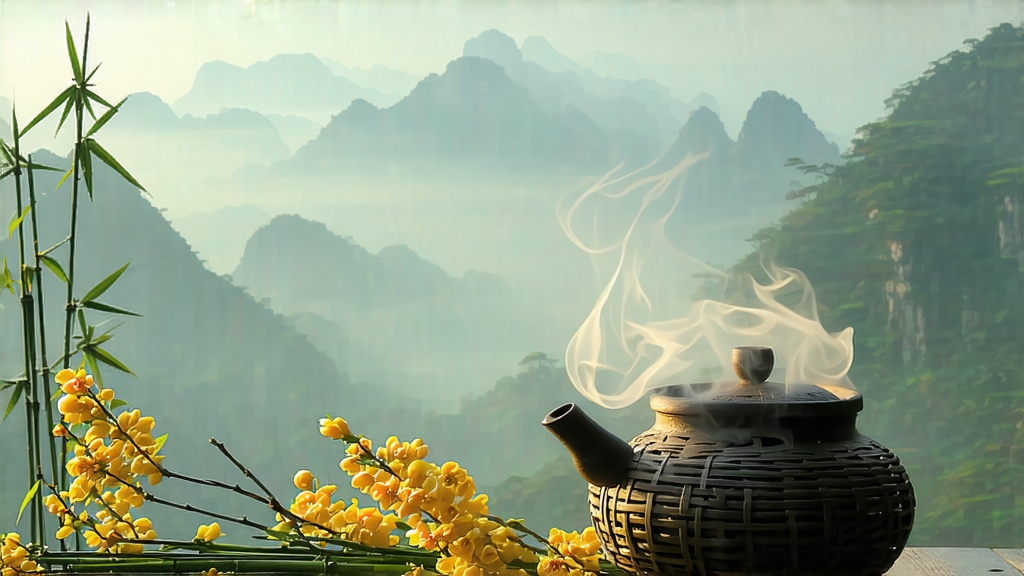
Tucked high on the mist-laden shoulders of Sichuan’s Mt. Meng, where clouds brush evergreen camellia canopies and the Min River whispers below, a tea once reserved for emperors still quietly unfolds its golden secret. Meng Ding Huang Ya—“the yellow bud from Meng Summit”—is the least exported yet most aristocratic member of China’s yellow-tea family. While green tea races to lock in freshness and dark pu-erh meditates for decades, Meng Ding Huang Ya lingers in a gentle twilight between oxidation and preservation, acquiring a color like late-afternoon sunlight and a flavor that bridges orchid, chestnut, and warm hay. To meet it is to step into a Song-dynasty scroll where scholars debated poetry over cups that glowed like topaz.
History: from palace banquets to mountain solitude
The first written record appears in 724 CE, when Tang emperor Xuanzong demanded “the bud that appears before Qingming rain.” Carried by post-horse relay, the tea covered 1,800 li in five days so that the throne could taste spring before anyone else. By the Song era the Meng Ding monastery had received an imperial stele granting its abbot sole right to harvest the 365 most perfect buds each year—one for every day of the calendar. When the Qing court shifted its favor to snakelike Longjing, Meng Ding Huang Ya retreated into monastic obscurity, produced only for local monks and the occasional traveling poet. It resurfaced in 1959 when Chinese tea scientists seeking “lost tribute teas” re-documented the technique, yet even today less than 3,000 kg leave Sichuan annually, most allocated to state banquets or discreet collectors.
Micro-terroir: why the mountain makes yellow possible
Mt. Meng’s unique “three clouds a day” phenomenon—dawn mist, midday fog, evening haze—filters sunlight into a soft, ultraviolet-rich glow. The slow photosynthesis raises the tea’s amino-acid ratio, especially L-theanine, which later becomes the creamy backbone of yellow tea’s flavor. At 1,450 m elevation, nights drop to 10 °C even in May; the cold shock forces the plant to store soluble sugars in its youngest buds, giving the leaf a natural sweetness that survives the arduous yellowing process. The soil is a crumbly quartz-rich granite that drains within minutes yet holds just enough moisture to keep the roots stress-free. Locals insist that the mountain’s wild orchids and ginkgo trees contribute airborne microbes that inoculate the withering leaf, adding a faint floral note impossible to replicate in lowland gardens.
Harvest calendar: the 72-hour window
Only the “winter sleep bud”—a plump tip that has rested for 180 days—is picked. The season opens on the first monkey cry of spring, traditionally between March 20 and 23, and closes when the local swallow population departs, rarely more than three days later. Pickers wear cotton gloves to avoid fingerprint oils and snap the bud with a sideways flick that leaves the tiny fish-leaf attached, a sign of perfection. The ideal leaf set weighs 0.3 g and must reach the monastery workshop within 40 minutes, before cellular respiration consumes the precious sugars.
Craft: the art of “men huang”—sealed yellowing
Unlike green tea’s quick kill-green, Meng Ding Huang Ya undergoes a 72-hour slow suffocation known as men huang. The fresh buds are first wok-fired at 85 °C for exactly 180 seconds; this “kills the green” but intentionally leaves 5 % moisture in the stem. While still warm, the leaf is wrapped in steamed bamboo skin and buried inside a 40 cm thick pile of roasted rice husk that holds 55 °C for four hours. The pile is turned every 30 minutes so that each bud “sweats” evenly, oxidizing at a snail’s pace. On the second day the leaf is removed, allowed to breathe for 20 minutes, then re-wrapped in fresh linen and left in a pine-wood cabinet kept at 38 °C and 75 % humidity. By the third dawn the leaf has turned a pale primrose; its grassy notes have mellowed into chestnut and dry mango. A final low-temperature bake at 60 °C for 90 minutes sets the aroma, after which the tea rests for one moon cycle so that residual moisture migrates from stem to tip, ensuring even shelf stability.
Grades: three expressions of the same bud
1)